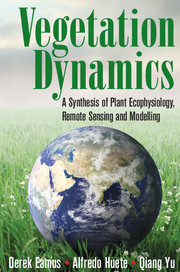Book contents
- Frontmatter
- Contents
- Preface
- Section One Plant Ecophysiology
- Section Two Remote Sensing
- 4 An Overview of Remote Sensing
- 5 Fundamentals and Physical Principles of Remote Sensing
- 6 Satellite Sensors and Platforms
- 7 Remote Sensing of Landscape Biophysical Properties
- Section Three Modelling
- Section Four Case Studies
- Index
- References
6 - Satellite Sensors and Platforms
from Section Two - Remote Sensing
Published online by Cambridge University Press: 05 June 2016
- Frontmatter
- Contents
- Preface
- Section One Plant Ecophysiology
- Section Two Remote Sensing
- 4 An Overview of Remote Sensing
- 5 Fundamentals and Physical Principles of Remote Sensing
- 6 Satellite Sensors and Platforms
- 7 Remote Sensing of Landscape Biophysical Properties
- Section Three Modelling
- Section Four Case Studies
- Index
- References
Summary
Introduction
There are numerous Earth orbiting satellite sensors that provide observations useful in assessing land cover conditions and landscape dynamics. These orbiting sensors measure spatial patterns of reflected and emitted energy from the land surface that can be used to generate geospatial image products of soil, vegetation, water and biogeochemical features. They measure changes over time through their repeat observations across a range of spatial and temporal scales. Satellite imagery extending back to the 1970s now provides a forty-plus year observation data record of dynamic ecosystem conditions and land surface changes. The synoptic coverage, higher-quality and consistency of satellite imagery have greatly improved the mapping of Earth resources compared with aerial photography.
A basic understanding of the variety of sensor designs and their characteristics is beneficial in correctly applying remote sensing tools to achieve various science and resource management objectives (Fig. 6.1). It is also important to know which sensors yield the appropriate type of remote sensing data to best answer specific ecological questions. Various sensor-dependent properties, such as pixel size, spectral bands, temporal repeat period, radiometric fidelity, polarization and viewing geometry are utilized to measure and characterize the Earth's surface. Each sensor system will have unique measurement strengths and limitations in its ability to characterise and retrieve land cover information.
There are many ways to classify the multitude of orbiting sensors and imagery available for ecosystem landscape studies. Important differentiating criteria may include the region of the electromagnetic spectrum (e.g., microwave, thermal, visible, near-infrared) being sensed, whether the energy source is active versus passive, sensor orbital characteristics (e.g., geostationary), frequency of image acquisition and sensor spatial resolution. In this chapter we introduce basic sensor principles, their design and properties, and discuss their respective capabilities and limitations in assessing land cover status, ecological variables, and landscape processes. Examples of the various types of sensor systems used in landscape studies are also highlighted.
Sensor Resolution
The resolution properties of a sensor define the magnitude and extent to which a sensor is able to discriminate variations and changes in landscape properties. In general, improved surface characterisations are achieved with finer resolution imaging capabilities. However, all sensors are limited by resolution constraints and signal noise limitations.
- Type
- Chapter
- Information
- Vegetation DynamicsA Synthesis of Plant Ecophysiology, Remote Sensing and Modelling, pp. 184 - 205Publisher: Cambridge University PressPrint publication year: 2016



